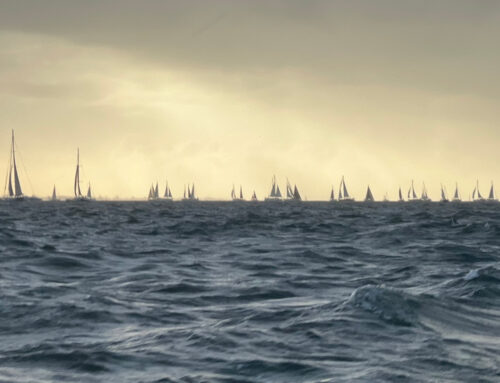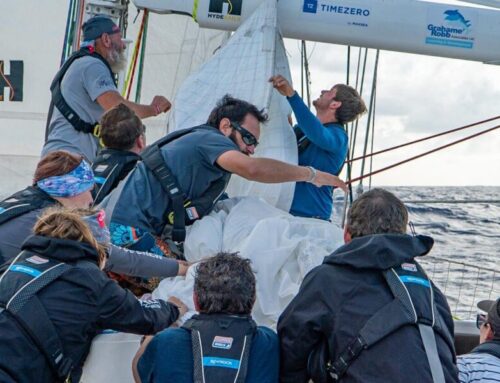Navigating corporate success through teamwork: Insights from the Clipper Race and wider business world.
In the unpredictable waters of business, leaders are increasingly turning to unconventional sources for inspiration for improvements in teamwork and productivity. One such reservoir of wisdom lies in our world of sailing – the intricate dance between wind, water, and teamwork when sailing a yacht mirrors the complexities of corporate success. As businesses seek strategies to navigate the challenges of a dynamic marketplace, Clipper Events is in a unique position to deliver valuable lessons learnt from knowing what it takes to race around the world on the Clipper Race.
In the below article we hear from experts across the sailing industry and business world who share their insights on the parallels between business and sailing.
Teamwork on deck, synergy in the boardroom
Successful sailing is a testament to the power of teamwork, where every member plays a vital role in the process. As entrepreneur and world-famous sailor, Alex Thomson (Clipper Race winning Skipper, and fastest British solo circumnavigator), notes, “if you take a kid and put them in a single-handed boat, you’re going to teach them independence, if you put them in a double-handed boat you’re going to teach them teamwork and communication.” (Alex Thomson, The Guardian)
Sailors understand that the effectiveness of a team is not just about individual skill but how well the team operates as a unit.
“During our team-building exercise (a sail day), sub-teams needed to be synchronised at all times and constantly communicate to ensure forward momentum. The acute awareness of interdependencies across the sub-teams was vital to achieve the most efficient outcomes.” – Philip Samson, Forbes

Adaptability: Navigating the winds of change
The sea is renowned for its capricious nature, and sailors must constantly adapt to changing conditions. This adaptability is a cornerstone of success not only in sailing but also in the ever-changing landscape of business.
Sailing teaches individuals to read the subtle signs of the wind and adjust the sails accordingly, something that can be likened to navigating market trends and adapting in the business world.
“On a sailboat you must constantly adjust course and sail trim to match the direction and velocity of the wind – conditions encountered while building businesses are no different, – you need to be ready to react and change the focus of your activities at a moment’s notice. Keeping an eye out for impending changes allows you to be proactive instead of reactive.” Peter Barrett, Fast Company
Risk Management: Sailing through uncertainty
Sailing involves a constant dance with risk – be it unpredictable weather or unforeseen obstacles. In the same vein, businesses face uncertainties that require strategic risk management. William Arthur Ward famously stated, “The pessimist complains about the wind; the optimist expects it to change; the realist adjusts the sails.”
Goal Setting: A sailing compass for business objectives
Setting sail without a destination is a venture into the unknown. Sailors set goals, plan routes, and adapt strategies to reach their chosen port. This goal-oriented mindset is directly translatable to the corporate world. Sailors don’t just aimlessly drift; they have a clear goal. Likewise, businesses need a clear vision, defined objectives, and a strategic plan to achieve success.
Annie Van de Wiele – “The art of the sailor is to leave nothing to chance”

Leadership at sea, leadership in business
The helm of a sailboat is a place of leadership, where the skipper makes critical decisions that impact the entire crew. Leading a crew requires a balance of authority and collaboration. In business, effective leaders must guide their teams with a similar blend of decisiveness and inclusivity.
“The leaders who work most effectively, it seems to me, never say “I.” And that’s not because they have trained themselves not to say “I.” They don’t think “I.” They think “we”; they think “team.” They understand their job to be to make the team function. They accept responsibility and don’t sidestep it, but “we” gets the credit. This is what creates trust, what enables you to get the task done.” Peter Drucker
In the Clipper Round the World Yacht Race, Skippers and First Mates echo the sentiment that leadership is about developing trust in the team, allowing leaders to step back with confidence. “It’s not the boat; all boats are the same so… no, the boat’s fine. It’s the people; it’s always been about the people,” emphasises a Clipper Race Skipper.
“It was in a skipper’s interest to develop trust in the crew to allow them to step back with confidence. By developing trust in the capability of the team, more energy can be spent on focusing on what is important for the overall performance of the organisation,” further emphasises Trudi West of Ashridge Business School in her research, “The Challenge of Leading: Insights from the Clipper Round the World Yacht Race.”
Conclusion: Sailing beyond the horizon of business success
As businesses chart their course through the unpredictable waters of today’s marketplace, the lessons learned from these corporate visionaries and the Clipper Race offer a valuable compass. The synergy between sailing and business is not merely metaphorical; it’s a tangible source of inspiration for leaders seeking innovative strategies for success. The sea, with its vastness and unpredictability, becomes a classroom where business leaders can learn the art of teamwork, adaptability, risk management, goal setting, and leadership development. In the words of Anthony T. Hincks, “Calm sailing doesn’t come from calm waters; it comes from having a good navigator; a good crew and a good vessel.”
Ready for team success? Explore the Clipper Events Leadership and Team Building packages here for a winning strategy to unlock your team’s full potential on board a Clipper Race yacht – built to train people completely new to sailing, creating a safe environment to learn.



